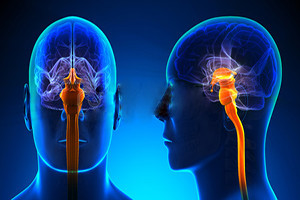Spinal Cord Injury
 The spinal cord is a collection of nerves that travels from the bottom of the brain down your back. There are 31 pairs of nerves that leave the spinal cord and go to your arms, legs, chest and abdomen. These nerves allow your brain to give commands to your muscles and cause movements of your arms and legs. The nerves that control your arms exit from the upper portion of the spinal cord, while the nerves to your legs exit from the lower portion of the spinal cord. The nerves also control the function of your organs including your heart, lungs, bowels, and bladder. For example, signals from the spinal cord control how fast your heart beats and your rate of breathing.
The spinal cord is a collection of nerves that travels from the bottom of the brain down your back. There are 31 pairs of nerves that leave the spinal cord and go to your arms, legs, chest and abdomen. These nerves allow your brain to give commands to your muscles and cause movements of your arms and legs. The nerves that control your arms exit from the upper portion of the spinal cord, while the nerves to your legs exit from the lower portion of the spinal cord. The nerves also control the function of your organs including your heart, lungs, bowels, and bladder. For example, signals from the spinal cord control how fast your heart beats and your rate of breathing.
Other nerves travel from your arms and legs back to the spinal cord. These nerves bring back information from your body to your brain including the senses of touch, pain, temperature, and position. The spinal cord runs through the spinal canal. This canal is surrounded by the bones in your neck and back called vertebrae which make up your back bone. The vertebrae are divided into 7 neck (cervical) vertebrae, 12 chest (thoracic) vertebrae and 5 lower back (lumbar) vertebrae. The vertebrae help protect the spinal cord from injury.
Spinal Cord Injury
The spinal cord is very sensitive to injury. Unlike other parts of your body, the spinal cord does not have the ability to repair itself if it is damaged. A spinal cord injury occurs when there is damage to the spinal cord either from trauma, loss of its normal blood supply, or compression from tumor or infection. There are approximately 12,000 new cases of spinal cord injury each year in the United States. They are most common in white males. Specifically, 80 % of spinal cord injuries occur in males, and 65 % occur in whites. Most injuries occur in patients under 30 years of age.
Spinal cord injuries are described as either complete or incomplete. In a complete spinal cord injury there is complete loss of sensation and muscle function in the body below the level of the injury. In an incomplete spinal cord injury there is some remaining function below the level of the injury. In most cases both sides of the body are affected equally.
An injury to the upper portion of the spinal cord in the neck can cause quadriplegia-paralysis of both arms and both legs. If the injury to the spinal cord occurs lower in the back it can cause paraplegia-paralysis of both legs only.
The Law Offices of Jonathan C. Capp is serving Spinal Cord Injury case clients in the following areas San Diego, CA, Escondido, CA, Carlsbad, CA, North County, CA and Coastal Area, CA. Call at (760) 231-6498 to consult with one of the best Spinal Cord Injury lawyers in California.

Call now for a free consultation; No win - no fee!
(760) 231-6498
